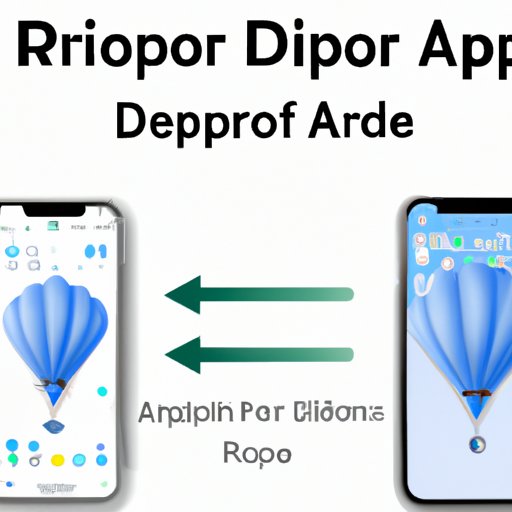Introduction
If you’ve ever wondered how to transfer files between your iPhone and Mac effortlessly, then Airdrop is the answer. This tool allows users to share photos, documents, video files, and even web pages between Apple devices easily.
In this article, we’ll walk you through the steps of using Airdrop to transfer files from your iPhone to Mac, as well as provide tips and tricks for hassle-free transfer. We also discuss potential issues that can arise along the way and how to mitigate them.
Step-by-Step Guide
Before initiating the transfer process, ensure that both your iPhone and Mac are updated to the latest software version. This guarantees that both devices have the latest Airdrop features.
1. Open the Control Center on your iPhone by swiping up from the bottom of the screen.
2. Click on the Airdrop button.

3. Once the button is clicked, select “Contacts Only” or “Everyone” depending on your preference. Select “Everyone” if you want anyone within your proximity to be able to locate and send you files. However, select “Contacts Only” if you want only the people in your contacts list to see your device.

4. Open Finder on your Mac, then click “Go” in the menu bar, and select “Airdrop.”
5. The Airdrop window will appear, displaying the available devices within your range that also have Airdrop enabled. Double-click on the device from which you want to receive the files.

6. Once the acceptance notification is received on the sender’s device, drag the desired file(s) to the Airdrop window’s recipient box. The file(s) will be sent immediately once you drop them in the recipient box.
Tips and Tricks
If you’re using Airdrop for the first time, complete the first transfer to ensure that the two devices are connected. The subsequent transmissions should be smoother and quicker.
When sending multiple files, select the files and drag all of them at once instead of sending them individually, which saves time and minimizes errors.
Video Tutorial
If you prefer learning visually, this video tutorial will guide you through the process of airdropping from iPhone to Mac:
Watching the video will significantly reduce the learning curve, making the process more accessible to visual learners.
Troubleshooting Guide
Occasionally, Airdrop may encounter problems, and here are some solutions:
- Ensure that both devices have Wi-Fi and/or Bluetooth enabled.
- Attempt to reset the devices. On the iPhone, go to “Settings” > “General” > “Reset” > “Reset Network Settings.” On the Mac, hold the “Shift + Option” keys together, and click on the Bluetooth icon in your menu bar to reveal “Debug” options. Click “Reset the Bluetooth module” to reset the device.
- Also, ensure that the devices are compatible with Airdrop and have the latest software versions installed.
- If you continue to encounter issues, contact Apple support for further clarification.
Use Case Scenarios
Airdrop is ideal for a wide range of scenarios, ranging from sharing memorable moments with family and friends to transferring files between colleagues. Here are a few scenarios:
- Sharing holiday pictures or family videos between iPhones and Macs. Airdrop allows you to share these files with Apple’s lightning-fast technology.
- Sending documents to colleagues. When collaborating with others, Airdrop is an efficient method of sharing documents or finalizing projects between fellow Apple device users.
- Sharing web pages with Macs. With Airdrop, you can move web pages from one device to the other with just a few clicks.
Alternative Methods
If Airdrop fails to work or isn’t viable, other methods exist for sharing files between iPhones and Macs. The availability of cloud services such as Dropbox, Google Drive, iCloud, and many others offer users many options.
However, each service comes with its benefits and drawbacks. To choose the best method for you, take into consideration the file size, internet speed, and upload/download requirements, as well as the privacy requirements.
iOS/macOS Compatibility
Airdrop requires Wifi and Bluetooth enabled devices running iOS 7 or newer and macOS X Yosemite 10.10 or newer versions.
To ensure that your device is compatible, go to “Settings” > “General” > “About” on your iPhone or “About this Mac” on your Mac to see the installed software versions.
However, if your device is not compatible, you can still share your files using the alternatives mentioned above.
Conclusion
Airdrop is an efficient means of transferring files between iPhones and Macs, but it is not without drawbacks. By following the steps outlined, considerations for compatibility, tips and tricks, and ways to overcome any issues, transferring files between Apple devices is smoother.
We hope that this guide has been helpful and, if you encounter any issues, seek Apple’s support.
